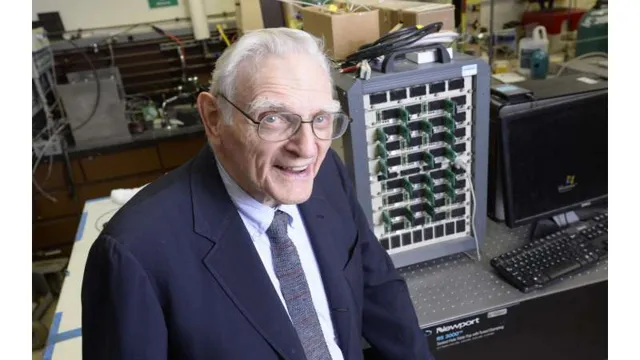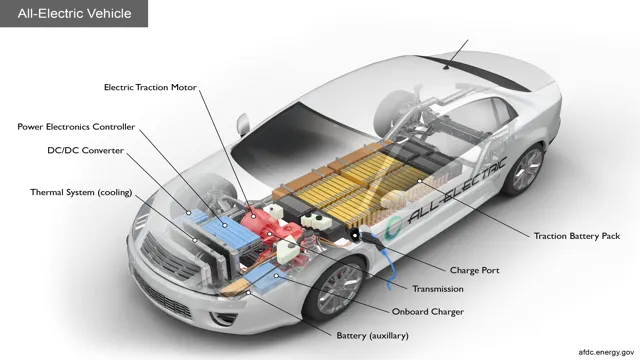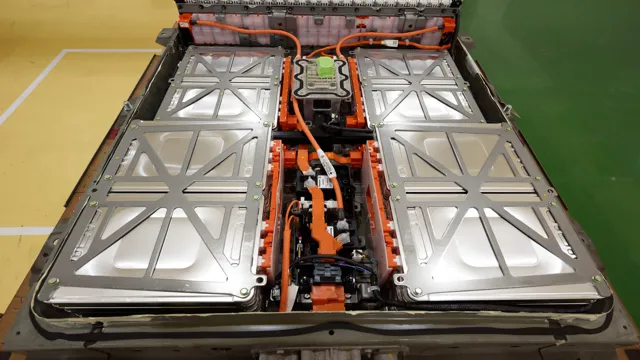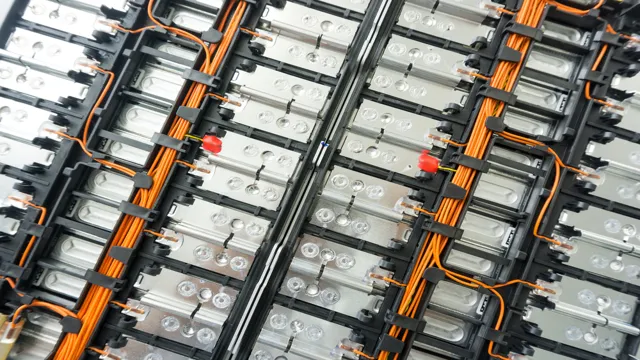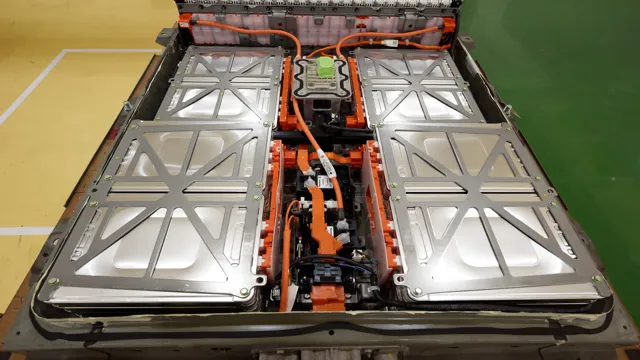Revolutionizing the Automotive Industry: Meet the Mind behind the Electric Car Battery Innovation
In a world where environmental concerns are becoming more evident each day, electric cars are becoming a more practical and popular solution to the problem of reducing carbon emissions. However, few people know about the man behind the invention of the electric car battery. Allow me to introduce you to John B.
Goodenough, a revolutionary inventor whose breakthroughs in battery technology have played a crucial role in shaping the future of sustainable energy. Goodenough, who is now in his nineties, has spent the better part of his life dedicated to advancing our understanding of materials science. His research led him to make a groundbreaking contribution to the field of energy storage when he invented the lithium-ion battery, which is now the standard for electric vehicles, smartphones, and laptops.
The lithium-ion battery has proven to be more efficient and long-lasting than its predecessors, making it a game-changer in the world of technology. In addition to his groundbreaking invention, Goodenough has continued to push the boundaries of battery technology. He has recently invented a solid-state battery that may offer even greater benefits than the lithium-ion battery, including a higher energy density and a longer lifespan.
These new innovations could have a significant impact on the electric car industry if they are successfully brought to market. In summary, John B. Goodenough is a trailblazing inventor whose contribution to battery technology has revolutionized the way we think about energy storage.
His work has paved the way for a more sustainable future, and his influence on the electric car industry cannot be overstated. We owe him a debt of gratitude for his tireless pursuit of knowledge and his dedication to creating a better world for all of us.
Who is the inventor?
The electric car battery inventor is John B. Goodenough, who is credited with co-inventing the lithium-ion battery alongside Akira Yoshino and M. Stanley Whittingham.
Goodenough is a retired physicist and professor from the University of Texas and has made numerous groundbreaking discoveries in the field of materials science. His work on lithium-ion batteries has revolutionized the power storage industry and paved the way for electric cars to become a viable source of transportation. The invention of the lithium-ion battery allowed for longer ranges, faster charging times, and more reliable performance in electric vehicles.
Goodenough’s contribution to the development of the electric car battery has been indispensable, and his work continues to inspire researchers and scientists around the world to develop better and more efficient energy storage solutions for a sustainable future.
Early life and background
The inventor behind a product or idea often goes unnoticed, and this is no exception in the case of many inventions we use daily. The early life and background of an inventor are often associated with the ideas and thought processes that led to their creation. For instance, the inventor of the telephone was Alexander Graham Bell, who grew up in Edinburgh, Scotland, and was surrounded by scientific and philosophical discussions from a young age.
He spent much of his youth studying speech and elocution, which later helped him in the invention of the telephone. Bell’s background and curiosity led him to explore the possibilities of transmitting sound waves through wires and eventually to the creation of the telephone, which revolutionized communication. Bell’s early life and background, coupled with his inquisitive nature, contributed to his discovery and fascination with sound and communication.

Breakthrough moment and invention
The inventor responsible for the breakthrough moment and the invention is a person who has immense creativity, curiosity, and innovative thinking. This person does not just think outside the box, but they are not limited by it. They have a sharp eye for identifying problems, and they are always looking for ways to solve them.
A perfect example of such an inventor is Thomas Edison, who is best known for inventing the first commercialized electric light bulb. Edison’s unique idea for a long-lasting light bulb was rooted in over 1000 experiments and testing different materials. His invention revolutionized the world as it provided light where there was darkness, extended working hours, and led to the creation of new industries.
Edison’s invention was the result of his consistent effort, persistence, and ability to think outside the box. His invention exemplifies the embodiment of innovation, intellectual creativity, and exceptional insight that an inventor possesses.
Impact on the automotive industry
When it comes to the inventor of the electric car, there is no single person who can be credited with it. However, there were various individuals who contributed to the development of the electric car as we know it today. In fact, the concept of an electric car dates back to the mid-to-late 19th century, when inventors such as Robert Anderson and Thomas Davenport began experimenting with electric-powered vehicles.
Since then, there have been numerous developments in the electric car industry, from the first practical electric vehicle developed in the 1800s to the modern electric cars of today, which are powered by advanced lithium-ion batteries. The impact of the electric car on the automotive industry is significant, with many car manufacturers now investing in this technology to meet the growing demand for more sustainable and environmentally-friendly vehicles. As the world continues to shift towards a greener future, it is clear that the electric car will play a key role in shaping the future of transportation.
How does it work?
The electric car battery inventor is an intelligent system that stores energy in the battery and powers the electric motor that drives the car. The inventor behind this groundbreaking technology developed a way to convert chemical energy into electrical energy and vice versa to make electric cars more practical and efficient. It works by using a combination of lithium-ion cells that store energy in the battery pack.
The power flow is controlled through a sophisticated electronic control unit, ensuring that the car draws the exact amount of energy it requires. This results in a vehicle that is not only more ecologically sound but also one that is more reliable and can be driven for longer distances than an average gasoline-powered car. What’s more, this innovative technology can be used to power other devices such as homes and businesses, making it a versatile and clever way to harness energy that doesn’t rely on fossil fuels.
With electric car battery inventors continuing to evolve and improve, we can expect to see even more promising developments in the future.
Components and design
The components and design of any device are crucial in determining how it works and its overall functionality. When it comes to technological devices, such as smartphones, the design plays a significant role in determining how it operates. The components of a smartphone are the hardware elements that work together to allow the device to function.
These components include the battery, processor, RAM, screen, camera, and other essential elements. The design of a smartphone affects its usability, aesthetics, and functionality. For example, the placement of the buttons and ports, the size of the screen, and the weight of the device are factors that are considered in its design.
The smartphone design also plays a crucial role in determining how easy it is to hold and to use, which is why manufacturers pay close attention to ergonomics. Ultimately, a successful smartphone design is one that combines the right components with thoughtful and functional design to create a device that users enjoy using.
Battery life and charging
Battery life and charging are essential aspects of all electronic devices that use batteries. Understanding how they work can help you prolong the lifespan of your devices and avoid potential hazards. The battery life is determined by the type of battery and how the device uses it.
For example, Lithium-ion batteries, commonly used in smartphones and laptops, have a limited number of charge and discharge cycles, so it’s important to avoid overcharging and undercharging them. Charging your device too often or leaving it plugged in past its full charge will reduce the battery’s capacity and lifespan. It’s best to charge your device in short bursts rather than leaving it plugged in all the time.
Moreover, using the right charger and cable that is appropriate for your device can also affect battery life. The charging process works by providing a flow of electrons from the charger to the battery. This flow of electrons fills the batteries’ inner cells, which stores energy until it’s needed.
When you use your device, the energy flows out of the battery, and the cycle repeats. It’s important to note that different devices require different charging speeds, voltage, and amperage, so it’s critical to use the right charger for your device. In conclusion, battery life and charging may seem like simple concepts, but understanding how they work and taking proper care of your devices can go a long way in preserving their longevity.
Future of electric car batteries
The future of electric car batteries looks promising, and it’s all thanks to the innovations of the electric car battery inventor. Over the years, we’ve seen major improvements in the range, performance, and durability of electric car batteries. Now, the race is on to develop even more efficient and cost-effective batteries.
One idea that’s gaining popularity is the use of solid-state batteries. Compared to traditional lithium-ion batteries, solid-state batteries are safer, have higher energy density, and are more efficient at charging and discharging. This could pave the way for longer-range electric vehicles that can charge in just minutes.
The electric car battery inventor has certainly come a long way, and we can’t wait to see what’s next on the horizon. With continued advancements in battery technology, electric cars may soon become the norm on our roads, helping to reduce our dependence on fossil fuels and protect the environment for future generations.
Advancements and improvements
As the technology behind electric cars continues to evolve, so do their batteries. The future of electric car batteries looks bright, with advancements in battery chemistry and manufacturing processes. More and more car manufacturers are investing in battery research, looking to improve the efficiency and the cost-effectiveness of these batteries.
In addition, government initiatives are also driving innovation in this area, with various countries offering incentives for the development of better and more sustainable electric car batteries. These new batteries can hold more charge, last longer, and be charged faster than previous generations. This means that not only are electric cars becoming a more practical alternative to traditional cars, but also a more environmentally friendly option.
With the future of electric car batteries promising a sustainable and efficient solution to our transportation needs, it’s only a matter of time until we see more and more of these vehicles on our roads.
Environmental impact and sustainability
Electric car batteries are the future of sustainable transportation. As more people become aware of the negative impact of fossil fuel emissions on the environment, electric cars are rising in popularity. However, the production and recycling of electric car batteries also have an impact on the environment.
That’s why battery technology is continuously evolving to become more efficient and eco-friendly. Scientists are working to develop batteries with longer lifespans, faster charging times, and lower costs. The key to a sustainable future is not only using electric cars but also developing sustainable methods of producing and recycling their batteries.
As the demand for electric cars increases, there is a greater need for responsible battery disposal and recycling to reduce their environmental impact. By adopting sustainable practices in battery production and recycling, we can achieve a cleaner, greener, and more sustainable future for generations to come.
Conclusion: The Power of Innovation
In conclusion, the inventor of the electric car battery was truly a revolutionary figure in the world of transportation. Not only did they pave the way for cleaner and more sustainable energy solutions, but their innovation has sparked a revolution in the automotive industry that will be felt for years to come. So the next time you see a sleek and efficient electric car on the road, remember to thank the visionary inventor behind the battery that powers it.
“
FAQs
Who is the inventor of the electric car battery?
The inventor of the electric car battery is Stan Ovshinsky.
When was the electric car battery invented?
The first practical electric car battery was invented in 1985 by Stan Ovshinsky.
How does the electric car battery work?
The electric car battery works by using stored electrical energy to power an electric motor.
What type of battery is used in electric cars?
Lithium-ion batteries are the most common type of battery used in electric cars.
